Showcasing the DNR: Meet Michigan’s forest fruit trees (some you may not have heard of)
By RACHEL COALE
Communications representative, Forest Resources Division
Michigan Department of Natural Resources
Following your feet down a woodland trail just might lead to a trove of wild treats – tiny, sweet strawberries, tart blueberries and juicy black raspberries – but peering upward into the forest canopy can also reveal unusual or forgotten fruits not found in a grocery store.
Read on to meet a few of these forest fruits found across portions of Michigan’s 4 million acres of state forest lands.
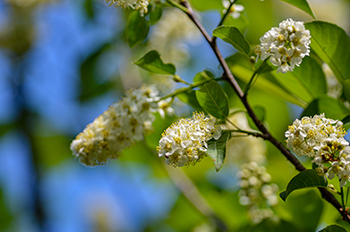
Chokecherry – Prunus virginiana
Pucker up! True to its name, the reddish-black fruit of the chokecherry tree (usually growing as a large bush) has a tart, astringent flavor that will cause you to make a sour face if you’re not expecting its assertive taste.
However, many foragers know that this mega-tart fruit can be tamed with the addition of sugar or honey, and makes a tasty jelly or syrup.
Chokecherries can be found growing in thickets and generally reach 10-20 feet tall. They have white flowers in the spring that attract butterflies, followed by small fruits in mid-summer.
Oval leaves are serrated and come to a point. Young trees have reddish-brown bark that turns darker brown with age. Chokecherries can be found in many different soil and growing conditions throughout Michigan but are especially common on woodland edges and along roads and trails.
Do not eat the leaves or pits of chokecherries, which can make people and animals sick. Always consume chokecherries cooked, not raw.
|
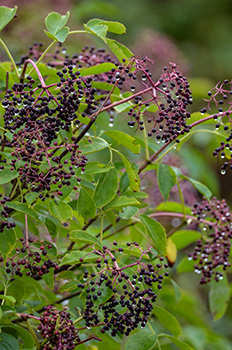
American elderberry – Sambucus canadensis
American elderberries are a late-summer forest treat, with juicy, purple fruit that is rich in flavor and healthful antioxidants.
This small tree or large shrub ranges from 5 to 12 feet tall and grows in thickets. Cream-colored clusters of star-shaped flowers open in early summer, benefiting bees and butterflies, followed by glossy purple berries in August or September.
Try using them in baked goods, preserves and in pies. They can also be used as a dye or to make ink. Don't eat uncooked elderberries, which can result in stomach upset. Blooms can also be used to make fragrant elderflower syrup.
According to the U.S. Department of Agriculture’s Forest Service, the American elderberry is usually found in moist forest edge habitat, in full or light shade. It often grows near lake and pond shores, low areas along roadways or in old fields.
|

Juneberry – several species in the Amelanchier genus
Depending on where you live in north America, juneberry varieties have a plethora of colorful names – juneberry, serviceberry, sarvisberry, shadbush, sugarplum and saskatoon are just a few.
Whatever you call them, these small trees or multi-stemmed bushes produce delicious, dark purplish fruits similar in size and taste to a blueberry. Fruits have a fringe-like crown on the end.
They can be used in much the same way as blueberries, eaten fresh or cooked into pies, muffins, pancakes or preserves. True to their common name, you can find the fruits ripening in June to July.
You can find juneberries growing back in open spaces after a wildfire or prescribed burn takes place, or on woodland edges. Juneberries are native to the upper Midwest and Canada, preferring cold climates and fire-adapted ecosystems.
Juneberries are recognizable by small white flowers that bloom in early spring and oval, finely toothed leaves that turn reddish in autumn.
|
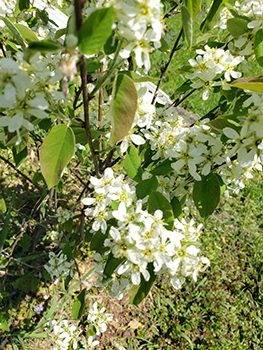
Mulberry – Morus alba
Most of us are familiar with the childhood rhyme, “all around the mulberry bush,” but have you ever tasted a mulberry?
Although the trees that bear these purple berries are widespread, the white mulberry is actually a non-native fruit brought to the United States during colonial times – and not for its berries!
Initially, colonists imported them with hopes to establish a silk industry. The silkworm’s preferred diet is mulberry leaves.
With its aggressive growth habit, the white mulberry has become naturalized into the landscape and is even invasive in some habitats. Known as a “messy tree,” for its abundant and staining berries, foragers can take a similar approach as with lemons – when life hands you mulberries, make a pie!
The mulberry tree has lobed leaves and orange-brown bark. The fruit ripens from white to purple in midsummer and resembles an elongated blackberry. It can be harvested by laying a sheet or tarp under the tree and gently shaking the branches to dislodge ripe berries.
Michigan is also home to a native species of mulberry, the rare red mulberry (Morus rubra), found in forested floodplains and swamps of the southern part of the state.
“The red mulberry is a protected, state-threatened species,” said Michigan Department of Natural Resources endangered species specialist Jennifer Kleitch. “If you find one, help protect this species by leaving it intact and do not pick fruit from the plants.”
Help scientists gather information on red mulberry distribution by reporting it to the Michigan Natural Features Inventory.
|
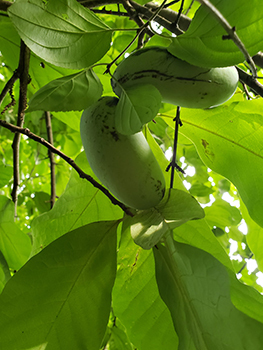
Pawpaw – Asimina triloba
With a taste described as a flavorsome cross between a banana and a mango, the pawpaw, also known as the prairie banana, is a little-known native tree with a taste of the tropics.
This small, deciduous understory tree has unusual, three-petaled purple flowers. It produces a large, funky, bean-shaped fruit 3-6 inches long with creamy, custard-like flesh.
They’re the only member of their family in North America; its closest relatives are trees native to Asia and include custard apples and ylang-ylang.
But why aren’t they more popular? The simple answer is, pawpaw fruits have a short shelf life and are too soft to ship well, so commercial production hasn’t taken off.
To taste this fascinating fruit, you’ll have to go right to the source, though the pulp can be frozen for future baking. Look for patches of these umbrella-shaped trees in shaded areas near stream banks and flood plains of the Lower Peninsula and follow your nose; the large leaves of this plant can smell faintly of gasoline!
|
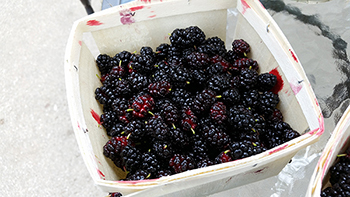
Heading out: Preparation is key
Michigan farmer’s market stalls are overflowing with tasty goodies like peaches, pears and plums. But if you head to the forest, you might be able to find something a little wilder.
Before you go foraging, make sure you have done your homework. Be able to correctly identify any wild plant that you plan to harvest and know methods to safely prepare it. Be aware of your surroundings – avoid picking from plants near roadways and ditches that collect runoff.
Also know what you can and can’t pick depending on where you are. In a state forest, harvesting fruits, berries, nuts and mushrooms is permitted. Activities that harm or kill a plant upon harvest are not permitted.
If you are canning your haul, always use a safe, tested recipe. University-produced publications such as those from Michigan State University Extension and the National Center for Home Food Preservation are good sources for up-to-date jam, jelly and syrup recipes.
Blogs and social media creators are not required to meet tested safety standards and may contain unsafe recipes.
Learn more about foraging and wild foods at Michigan.gov/Foraging.
Check out previous Showcasing the DNR stories on our Showcasing webpage. To subscribe to upcoming Showcasing articles, sign up for free email delivery at Michigan.gov/DNR.
|
Note to editors: Contact: John Pepin, Showcasing the DNR series editor, 906-226-1352. Accompanying photos and a text-only version of this story are available below for download. Caption information follows. Credit Michigan Department of Natural Resources, unless otherwise noted.
Text-only version of this story.
Chokecherries: Chokecherry flowers blooming on a May morning in Marquette County.
Elderberries: Elderberries are shown growing along a stream in Marquette County.
Juneberry: Juneberries are a delightful fruit of summertime in Michigan. (Shutterstock image)
Production: Even a small mulberry tree can be a very prolific berry producer.
Spring: Spring juneberry blossoms are an indicator of sweet things to come.
Staining: Hands stained with mulberries are a welcomed part of this forest fruit harvest.
Wild: Wild paw paw fruit are shown growing on a ridge near a river in Eaton County.
|